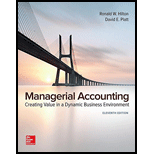
1 a.
Explain how breakeven point in units is calculated by using the contribution margin approach.
1 a.
Explanation of Solution
Break-even Point: It refers to a point in the level of operations at which a company experiences its revenues generated is equal to its costs incurred. Thus, when a company reaches at its break-even point, it reports neither an income nor a loss from operations.
Contribution Margin: The process or theory which is used to judge the benefit given by each unit of the goods produced is called as contribution margin. The contribution margin is the difference between the selling price and the cost of the product.
By using the contribution margin approach, the breakeven point in units is calculated as below:
1 b.
Explain how breakeven point in units is calculated by using the equation approach.
1 b.
Explanation of Solution
Equation approach: Equation approach is an alternative way to find out the breakeven point. It is based on the profit equation.
By using the equation approach, the breakeven point in units (sales volume in units) is calculated as below:
3.
Explain how breakeven point in units is determined by using the graphical approach.
3.
Explanation of Solution
Sales revenue and total expenses are graphed according to the graphical approach. The point of intersection of total revenue and total expenses is considered as the break -even point.
Want to see more full solutions like this?
Chapter 7 Solutions
Managerial Accounting: Creating Value in a Dynamic Business Environment
- How much should be recorded as goodwill??arrow_forwardNot use ai solution please and accounting questionarrow_forwardOn January 1, 2025, Fisher Company makes the two following acquisitions. 1. 2. Purchases land having a fair market value of $800,000 by issuing a 5-year, zero-interest-bearing promissory note in the face amount of $1,175,468. Purchases equipment by issuing a 4%, 8-year promissory note having a maturity value of $350,000 (Interest payable annually on January 1). The company has to pay 8% interest for funds from its bank. (a) (b) Record the two journal entries that should be recorded by Fisher Company for the two purchases on January 1, 2025. Record the interest at the end of the first year on both notes using the effective-interest method. (Round present value factor calculations to 5 decimal places, e.g. 1.25124 and the final answer to O decimal place, e.g. 58,971. If no entry is required, select "No Entry" for the account titles and enter O for the amounts. Credit account titles are automatically indented when the amount is entered. Do not indent manually. List all debit entries…arrow_forward
- Principles of Accounting Volume 2AccountingISBN:9781947172609Author:OpenStaxPublisher:OpenStax CollegePrinciples of Accounting Volume 1AccountingISBN:9781947172685Author:OpenStaxPublisher:OpenStax College
 Individual Income TaxesAccountingISBN:9780357109731Author:HoffmanPublisher:CENGAGE LEARNING - CONSIGNMENT
Individual Income TaxesAccountingISBN:9780357109731Author:HoffmanPublisher:CENGAGE LEARNING - CONSIGNMENT  Principles of Cost AccountingAccountingISBN:9781305087408Author:Edward J. Vanderbeck, Maria R. MitchellPublisher:Cengage Learning
Principles of Cost AccountingAccountingISBN:9781305087408Author:Edward J. Vanderbeck, Maria R. MitchellPublisher:Cengage Learning





